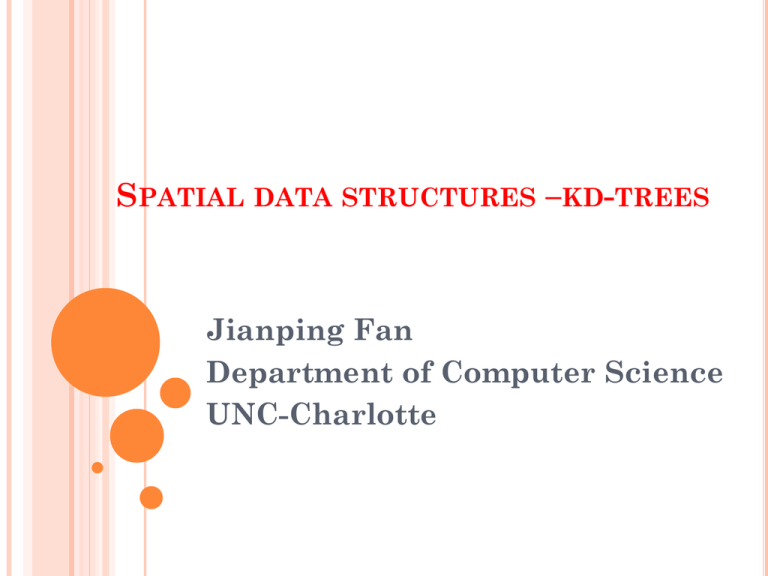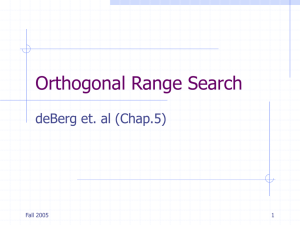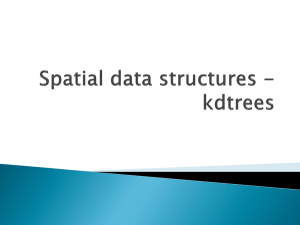Spatial data structures
advertisement

SPATIAL DATA STRUCTURES –KD-TREES Jianping Fan Department of Computer Science UNC-Charlotte SUMMARY This lecture introduces multi-dimensional queries in databases, as well as addresses how we can query and represent multi-dimensional data “A reasonable man adapts himself to his environment. An unreasonable man persists in attempting to adapt his environment to suit himself …Therefore, all progress depends on unreasonable man” George Bernard Shaw CONTENTS Definitions Basic operations and construction Range queries on multi-attributes Variants Applications USAGE Rendering Surface reconstruction Collision detection Vision and machine learning Intel Interactive technology KD TREE DEFINITION A recursive space partitioning tree. – Partition along x and y axis in an alternating fashion. – Each internal node stores the splitting node along x (or y). K-D TREE Used for point location and multiple database quesries, k –number of the attributes to perform the search Geometric interpretation – to perform search in 2D space – 2-d tree Search components (x,y) interchange! K-D TREE EXAMPLE d d c e f b a f b c a e KD TREE EXAMPLE 3D KD TREE CONSTRUCTION The canonical method of kd-tree construction is the following: As one moves down the tree, one cycles through the axes used to select the splitting planes. (For example, the root would have an x-aligned plane, the root's children would both have y-aligned planes, the root's grandchildren would all have z-aligned planes, the next level would have an x-aligned plane, and so on.) Points are inserted by selecting the median of the points being put into the subtree, with respect to their coordinates in the axis being used to create the splitting plane. (Note the assumption that we feed the entire set of points into the algorithm up-front.) CONSRUCTION This method leads to a balanced kd-tree, in which each leaf node is about the same distance from the root. However, balanced trees are not necessarily optimal for all applications. Note also that it is not required to select the median point. In that case, the result is simply that there is no guarantee that the tree will be balanced. A simple heuristic to avoid coding a complex lineartime median-finding algorithm or using an O(n log n) sort is to use sort to find the median of a fixed number of randomly selected points to serve as the cut line KD TREE – MEAN VS MEDIAN kd-tree partitions of a uniform set of data points, using the mean (left image) and the median (right image) thresholding options. Median: The middle value of a set of values. Mean: The arithmetic average. (Andrea Vivaldi and Brian Fulkersson) http://www.vlfeat.org/overview/kdtree.html EXAMPLE OF USING MEDIAN ADDITIONS One adds a new point to a kd-tree in the same way as one adds an element to any other search tree. First, traverse the tree, starting from the root and moving to either the left or the right child depending on whether the point to be inserted is on the "left" or "right" side of the splitting plane. Once you get to the node under which the child should be located, add the new point as either the left or right child of the leaf node, again depending on which side of the node's splitting plane contains the new node. Adding points in this manner can cause the tree to become unbalanced, leading to decreased tree performance DELETIONS To remove a point from an existing kd-tree, without breaking the invariant, the easiest way is to form the set of all nodes and leaves from the children of the target node, and recreate that part of the tree. Another approach is to find a replacement for the point removed. First, find the node R that contains the point to be removed. For the base case where R is a leaf node, no replacement is required. For the general case, find a replacement point, say p, from the sub-tree rooted at R. Replace the point stored at R with p. Then, recursively remove p. BALANCING Balancing a kd-tree requires care. Because kdtrees are sorted in multiple dimensions, the tree rotation technique cannot be used to balance them — this may break the invariant. Several variants of balanced kd-tree exists. They include divided kd-tree, pseudo kd-tree, K-D-Btree, hB-tree and Bkd-tree. Many of these variants are adaptive k-d tree. QUERING Kdtree query uses a best-bin first search heuristic. This is a branch-and-bound technique that maintains an estimate of the smallest distance from the query point to any of the data points down all of the open paths. Kdtree query supports two important operations: nearest-neighbor search and k-nearest neighbor search. The first returns nearest-neighbor to a query point, the latter can be used to return the k nearest neighbors to a given query point Q. For instance: NEAREST-NEIGHBOR SEARCH Starting with the root node, the algorithm moves down the tree recursively (i.e. it goes right or left depending on whether the point is greater or less than the current node in the split dimension). Once the algorithm reaches a leaf node, it saves that node point as the "current best" The algorithm unwinds the recursion of the tree, performing the following steps at each node: RECURSION STEP If the current node is closer than the current best, then it becomes the current best. ◦ The algorithm checks whether there could be any points on the other side of the splitting plane that are closer to the search point than the current best. In concept, this is done by intersecting the splitting hyperplane with a hypersphere around the search point that has a radius equal to the current nearest distance. ◦ If the hypersphere crosses the plane, there could be nearer points on the other side of the plane, so the algorithm must move down the other branch of the tree from the current node looking for closer points, following the same recursive process as the entire search. ◦ If the hypersphere doesn't intersect the splitting plane, then the algorithm continues walking up the tree, and the entire branch on the other side of that node is eliminated. NEAREST-NEIGHBOR SEARCH kd-trees are not suitable for efficiently finding the nearest neighbour in high dimensional spaces. In very high dimensional spaces, the curse of dimensionality causes the algorithm to need to visit many more branches than in lower dimensional spaces. In particular, when the number of points is only slightly higher than the number of dimensions, the algorithm is only slightly better than a linear search of all of the points. The algorithm can be improved. It can provide the kNearest Neighbors to a point by maintaining k current bests instead of just one. Branches are only eliminated when they can't have points closer than any of the k current bests. RANGE SEARCH Kd tree provide convenient tool for range search query in databases with more than one key. The search might go down the root in both directions (left and right), but can be limited by strict inequality on key value at each tree level. Kd tree is the only data structure that allows easy multi-key search. KD TREE http://upload.wikimedia.org/wikipedia/en/9/9c/KDTree-animation.gif COMPLEXITY Building a static kd-tree from n points takes O(n log 2 n) time if an O(n log n) sort is used to compute the median at each level. The complexity is O(n log n) if a linear medianfinding algorithm such as the one described in Cormen et al.] is used. Inserting a new point into a balanced kd-tree takes O(log n) time. Removing a point from a balanced kd-tree takes O(log n) time. Querying an axis-parallel range in a balanced kdtree takes O(n1-1/k +m) time, where m is the number of the reported points, and k the dimension of the kdtree. KD TREE OF RECTANGLES Instead of points, a kd-tree can also contain rectangles. A 2D rectangle is considered a 4D object (xlow, xhigh, ylow, yhigh). Thus range search becomes the problem of returning all rectangles intersecting the search rectangle. The tree is constructed the usual way with all the rectangles at the leaves. In an orthogonal range search, the opposite coordinate is used when comparing against the median. For example, if the current level is split along xhigh, we check the xlow coordinate of the search rectangle. If the median is less than the xlow coordinate of the search rectangle, then no rectangle in the left branch can ever intersect with the search rectangle and so can be pruned. Otherwise both branches should be traversed. Note that interval tree is a 1-dimensional special case. APPLICATIONS Query processing in sensor networks Nearest-neighbor searchers Optimization Ray tracing Database search by multiple keys EXAMPLES OF APPLICATIONS Population, ’96 0 100Km. Population Distribution in Alberta, 1996 census PROGRESSIVE MESHES Developed by Hugues Hoppe, Microsoft Research Inc. Published first in SIGGRAPH 1996. TERRAIN VISUALIZATION APPLICATIONS GEOMETRIC SUBDIVISION Problems with Geometric Subdivisions ROAM PRINCIPLE The basic operating principle of ROAM REVIEW QUESTIONS Define kd tree What is the difference from B tree? R tree? Quad tree? Grid file? Interval tree? Define complexity of basic operations What is the difference between mean and median kd tree? List typical queries – nearest-neighbor, k nearest neighbors Provide examples of kd tree applciations SOURCES In-line references to current research in the area and variety of research papers and web sources and applications. DECISION TREE Database indexing structure is built for decision making and tries to make the decision as fast as possible! Color = yes no Green? Size = Big? yes watermelo n Color = yes Yellow? no Size = Medium? yes apple no Grape Shape = Round? yes no Size = Big? yes no grapefruit no Size = small? yes no apple bananaTaste = sweet? yes no lemon cherry grape DECISION TREE How to obtain decision for a database? a. Obtain a set of labeled training data set from the database. b. Calculate the entropy impurity: i(n) p( j ) log2 p( j ) j c. Classifier is built by: maxi(n) KD-TREE By treating query as a decision making procedure, we can use decision to build more effective database indexing! Database root node no Salary > $75000? yes Age > 60? no yes no Data table Age > 60? yes no KD-TREE Each inter-node, only one attribute is used! It is not balance! Search from different node may have different I/O cost! It can support multiple attribute database indexing like R-tree! It has integrated decision making and database query! KD-TREE Tree levels: N; Leaf nodes: M; Number of data entries for leaf node: K The inter-nodes for kd-tree at the same level are stored on the same page. a. Equal query: N + M b. Range query: N + M c. Insert: N + M + 1 d. Delete: N+ M + 1 STORAGE MANAGEMENT FOR HIGHDIMENSIONAL INDEXING STRUCTURES We want to put the similar data in the same page or neighboring pages! CLUSTERED CLUSTERED UNCLUSTERED Index entries direct search for Index entries data entries direct search for data entries UNCLUSTERED Data entries Data entries Data entries (Index File) Data entries (Data File) file) (Index (Data file) Data Records Data Records Data Records Data Records STORAGE MANAGEMENT FOR HIGHDIMENSIONAL INDEXING STRUCTURES It is very hard to do multi-dimensional data sorting Hilbert Curve: scale multi-dimensional data into one dimension. 00 01 10 11 STORAGE MANAGEMENT FOR HIGHDIMENSIONAL INDEXING STRUCTURES 0 3 4 5 1 14 1 5 2 13 1 2 7 8 1 1 6 9 1 0 From multi-dimensional indexing to one-dimensional storage in disk!









